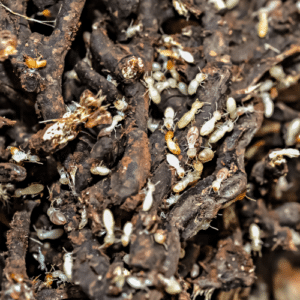
Subterranean Termite

Subterranean Termites: Habitat, Habits, and Harm
Subterranean termites, often referred to simply as “subterranean termites,” are fascinating creatures that thrive in colonies deep underground. These minuscule yet highly impactful insects are commonly found in regions with warm climates, such as southern Florida, where they wreak havoc by feeding on wood and causing structural damage to buildings. In this in-depth exploration of Subterranean Termites, we will delve into various aspects of their existence, from their habitat and reproductive system to their feeding habits, ecological implications, anatomy, life cycle, and more.
Subterranean termites are aptly named, as they predominantly inhabit subterranean environments. They are renowned for their remarkable ability to construct intricate tunnel systems, often referred to as “mud tubes.” These mud tubes serve as vital passageways between their subterranean colonies and their primary source of sustenance—wood. Subterranean termites thrive in environments that offer both a moisture-rich atmosphere and a readily available wood supply. This dual requirement makes soil and wood the perfect habitat for these tenacious insects.
Subterranean termites are voracious eaters with a particular penchant for cellulose—a key component found in wood and plant materials. These insects play a vital role in ecosystems by breaking down dead and decaying wood, thus facilitating the recycling of essential nutrients. However, their feeding habits become problematic when they target the wooden structures of homes and businesses, leading to significant structural damage.
Roles, Anatomy, and Life Cycle
Within a subterranean termite colony, a well-organized caste system is in place, consisting of distinct roles: workers, soldiers, and the king and queen. The queen, the central figurehead of the colony, plays a pivotal role in the reproductive process by laying thousands of eggs daily. As the eggs hatch, they progress through various developmental stages, including nymphs, eventually assuming the roles of workers or soldiers, depending on the colony’s needs.
Subterranean termites are relatively small insects, typically measuring between 1/8 to 1 inch in length. They possess soft bodies with a coloration ranging from creamy-white to pale-yellow. Their anatomy comprises three distinct segments: the head, thorax, and abdomen. Unlike ants, termites feature straight antennae and lack the distinctive waistline that distinguishes the thorax from the abdomen in ants.
The life cycle of a subterranean termite spans several stages, including egg, nymph, worker, soldier, and reproductive. The process commences with the queen laying eggs, which eventually hatch into pale, wingless nymphs. These nymphs undergo transformation, developing into workers and soldiers responsible for colony maintenance and defense. Reproductive termites, distinguished by their wings, embark on swarming journeys to establish new colonies.
From Ancient Origins to Modern Challenges
While subterranean termites serve as nature’s recyclers, breaking down dead plant material in ecosystems, their presence can have detrimental effects when they infest human-made structures. Such infestations can result in extensive structural damage, leading to costly repairs for homeowners and businesses alike. Moreover, the necessity for chemical treatments to control these pests can have adverse environmental consequences.
Subterranean termites have been around for an astounding 120 million years, as indicated by fossil records dating back to the Early Cretaceous period. This extensive evolutionary history underscores their adaptability and resilience as a species.
Subterranean termites are highly invasive when they infest structures. They possess the uncanny ability to infiltrate buildings through cracks, gaps, and any untreated wood-to-soil contact. Their aptitude for remaining concealed within walls and crawlspaces makes them difficult to detect until substantial damage has occurred, posing a significant threat to homes and businesses alike.
While subterranean termites do not directly endanger human health, their presence can indirectly affect it. Infestations may result in weakened structures, potentially leading to collapses and injuries. Furthermore, the stress and financial burden incurred while dealing with termite damage can adversely impact homeowners’ well-being.
Conclusion
Subterranean termites are intriguing insects with a rich history on Earth. While they serve an invaluable ecological role as decomposers, their infestations in human-made structures can be devastating. Understanding their habitat, reproductive system, feeding habits, and ecological repercussions is vital for effective pest control and prevention. To safeguard your home or business from these relentless invaders, consider seeking professional assistance from experts like Pest Busterzz, who can help manage and mitigate the risks associated with subterranean termite infestations.
